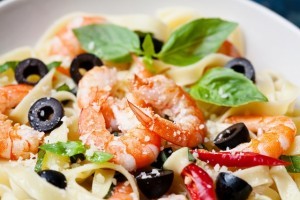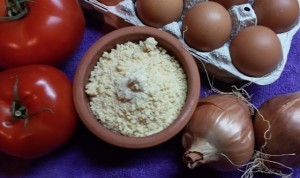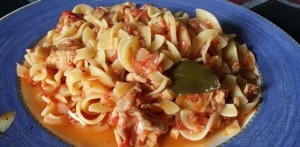Chylopites, kofto macaronaki, kouskousaki, kritharaki, trachanas…these words may sound weird to you, but they are all types of Greek pasta which are used in everyday recipes around Greece. Pasta is made with ingredients such as milk, wheat and eggs. They are usually topped with a tomato-red or creamy-white sauce, cheese, seafood or meat, and not to mention that they are great served with legumes, in soups or salads. Pasta can have a profound effect on your energy levels; not only do they make excellent dishes but they also supply your body with carbohydrates, vitamins, protein, calcium and minerals.
As it once used to be…
In the past, women used to make their own home made pasta, usually during the summer months (after harvesting), when plenty of raw material was available. They made the dough, worked it, cut or rubbed it by hand into small pieces and then laid it out in the sun to dry. Then, the pasta was put away in fabric pouches in their cellars to have throughout the year.
Nowadays, grandmother’s tradition has passed on to small family businesses and women’s cooperatives that craft the fine high quality pasta as it used to be, using only the best of materials.
A fantasy of names
Greek imagination and creativity have been an inspiration for pasta’s names as well as for their different shapes despite being crafted with the same raw material. Let us introduce you to some of them, found throughout the country, bearing various imaginative names.
The traditional pasta in the Peloponnese, especially in the area of Lakonia and Argolida, has a shell-like shape bearing the name gkogkes. This pasta is usually offered during the carnival period, boiled, sprinkled with local manouromyzithra cheese sprinkled with hot olive oil. Furthermore, striftades (rice-like pasta) and toutoumakia (greek noodles, little square stamp-like shape) are also found in the area.
In Mainland Greece you must try their renowned trachanas; sweet or sour, thick or thin, with semolina, flour, or bulgur wheat, with butter, milk or tomato, it is a must have dish during the cold winter days and nights. It is served neat, as a thin or thick soup, sprinkled with chunks of feta cheese, cooked along side with vegetables and legumes, accompanied by meat, or as a filling in pies and in dolmadakia. Trachanas is truly appreciated as it is very nutritious and is served even for breakfast in the countryside. The one made with vegetable pulp, flour or semolina is usually prefered during the lent period. There is no doubt that Greece holds a leading position as the country with the biggest variety of trachanas worldwide. In Epirus they include mushrooms in their dough. In Thrace sesame and red pepper flakes and in Macedonia pulp of red pepper.
On the island of Crete the inhabitants regularly use chondros, which is in fact trachanas, in their local cuisine. When visiting the island ask for “gyreuthous chochlious,” which is in fact snails cooked alongside with vegetables and chondros, and Cretans are really fond of this dish. Chondros is also made with sour milk or yogurt and goes by the name xinochondros. Other great pasta you can encounter here are: sioufichta, kalogeristika makaroni, avgochylos (short type of tagliatelles), chylofta (resemble linguini), triftoudia (rice like shape), and magkiri (small square-shaped pasta.) All these are simply irresistible, especially if they are sprinkled with staka (butter-cream) and anthotyro (greek soft white cheese).
Makarounes is a pasta originating from the islands scattered in the northeast Aegean Sea.On Karpathos and Tilos Islands makarounes look like tagliatelles. On Kos they are known as pasa makarounes, which are large flat fresh sheets of pasta dough (look like wide lasagna), and are cooked in layers with plenty of minced meat or cheese in between. Kasos Island’s special recipe is makarounes (they resemble penne) with sitaka (soft local cheese). Chios has aftoudia, which is an ear-shaped pasta made with flour and water. On the island you can also find valanes, small spiral shape pasta, ideal to accompany rooster with tomato sauce. Limnos’ traditional pasta is flomaria and is made with eggs, milk and hard wheat flour. They are usually cut into noodle-like wide stripes or string-like as spaghetti.
Aroma filled pasta dishes inspired in Greece
Matsata with rooster – A traditional recipe from Folegandros
Take the rooster and cut it into serving size pieces, then cook in pan with lots of olive oil, sliced onions, garlic, tomato sauce and spices. When the rooster gets tender set aside then add the already boiled matsata pasta to your sauce in order to absorb the aromas and flavours. Serve the pasta dish with a piece of rooster and sprinkle with grated myzithra.
Red Trachanas recipe – A Thracian delicacy
The dough of this particular trachanas is made with pieces of red pepper, red pumpkin and potato. For each serving you must take into account that you’ll need three soup spoons of trachanas and one cup of water. Bring your water to a boil before putting in the trachanas and let it simmer until it becomes mushy. For extra taste add some chunks of feta cheese.
Giouvetsaki Casserole Dish – A Greek Classic Sunday Family Recipe
Brown your meat (veal or lamb) in a pot together with chopped onion and add one tea cup of water, let it simmer for 15 minutes. Empty your pot in a casserole dish, add tomato sauce and paste, garlic, a cinnamon stick, salt and pepper. Cover the meat by filling up with warm water and let it cook for approximately 2 hours. Add kritharaki (orzo) and stir occasionally. Serve with grated cheese.
Bon appetit!
Source: visitgreece.gr










































